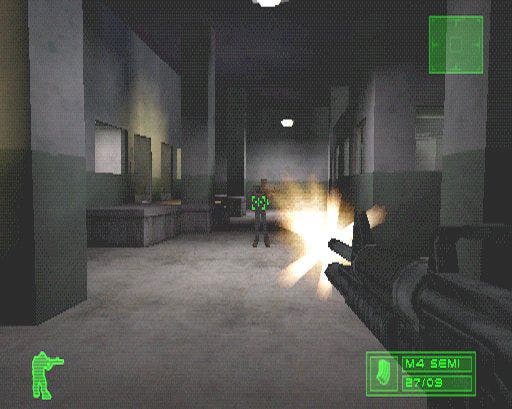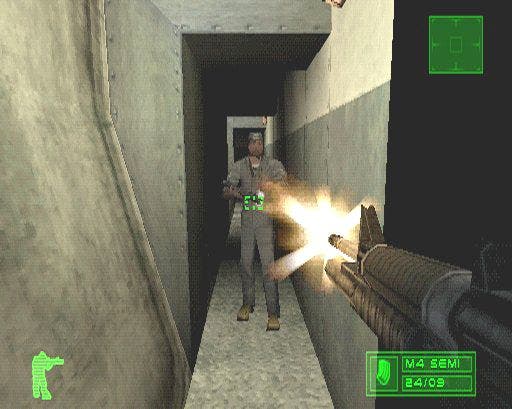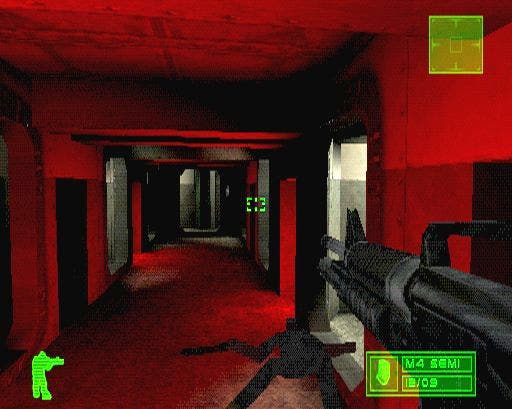Wes Eckhart of Novalogic
Interview - we chat to Novalogic about their upcoming PSone shooter, Delta Force: Urban Warfare
Rebellion's Delta Force: Urban Warfare is a peculiar application of the UK's foremost first person shooter developer. It seems strange, to us at least, that a company whose products are synonymous with high quality would be working on a PSone action game. We caught up with publisher Novalogic's Wes Eckhart to find out what the hell is going on.

Departure
The PlayStation has had a decent innings. In Europe alone the installed base of units tops 35 million machines, and with a new £49.99 price tag the console seems like a better proposition than ever, but there are now three subsequent generation consoles on the market for punters to consider. Why on earth is Rebellion doing Delta Force on the PlayStation?
It's simple. "As huge fans of the Delta Force series and the first person shooter genre in general, Rebellion jumped at the opportunity to bring the first Delta Force franchise to the PlayStation", Wes explains. "With such a huge installed base, the PlayStation is still an extremely important market and should not be dismissed by developers and publishers alike with the advent of the third generation machines."
Obviously working with the aging console does bring its drawbacks, and partly because of this the emphasis Rebellion has shifted away from the long range outdoor engagements typically found in Delta Force games. "While sniping is available in the game, the core gameplay focuses on Close Quarters Battle. The PS2 version of the DF franchise [due out in April] offers gamers intense first and third-person shooter action, with missions divided between close quarters combat and long-range sniping. Using the adjustable scope on the sniper rifle, players can bring the enemy and surrounding terrain into vivid detail, allowing the player to pull the trigger first, often from a concealed position. "

Over The Edge
Despite the limitations of the hardware, Delta Force is a surprisingly advanced game, technologically. "The environments are very detailed - these include ultra-realistic effects, such as accurate wounding and object damage. Glass shatters when windows are shot out, lights can be blown out to darken a room, and once wounded you'll leave blood trails that your enemies can follow."
And with such an enormous market to aim at, developing for the PSone makes good financial sense. Games can be shorter, cost less to develop and don't require top of the range graphics and audio to chart. Indeed, in the absence of blockbusting new PSone titles, Delta Force is quite a good bet to chart well. But consumers will still want something new, and something that offers a challenge worthy of their hard earned cash. Innovation, it would seem, is highly desirable within the platform's confines.
"Firstly we offer gamers a massive amount of action", Wes told us. "Players can crouch, crawl, drag and hide enemy bodies, plant explosives and listen in on enemy radio transmissions. Combine this with some sophisticated AI and you have a game that is going to be an absolute blast to play, and while the primary gameplay is fast-paced action, there are certain levels and puzzles in the game which require stealth and patience."
"Secondly, Delta Force's contemporary setting and realistic edge allows us to have a huge range of cool weapons, gadgets and visual effects. Traditionally the benchmark first person shooter for the PlayStation is EA's Medal of Honor. In comparison to MOH's six weapons we have nearly twenty. Players can use a range of Delta Force hi-tech equipment: night and thermal vision goggles, stun guns, stun grenades, claymores with infra-red trip wires, radio detonated C4 charges. On top of this the operative will be equipped with electronic lock picks, a security camera jammer, and a combat radar."

More Than A Shooter
It all sounds eerily familiar, but just how much of the game is actually inspired by the PC Delta Force titles? "The basic idea behind Delta Force on the PlayStation is the use of modern weapons and tactics to accomplish your missions. This is at the core of the PC product", according to Wes. "To bring the game to the PlayStation, we've added a much more interesting story element which really draws the player into the intrigue. You'll still have the ability to use the MP5 or the SAW, and even the Barrett .50 cal to snipe enemies from a distance."
One thing that has bothered me since I first saw Delta Force in action is that for all the impressive aspects of the game already in place - the weaponry, the models, the scenery and the environmental effects, and the overall feeling of authenticity - the game lacks any real structure. A bit like the action movies of the same name paraded on Channel 5 once a week. This is because it's only just approaching the point of no return, the point at which Rebellion will take this impressive technology and weave a story of intrigue throughout the game's numerous locations.
"Delta Force has been built around a strong and cohesive story line", Wes revealed. "In Urban Warfare the player takes the role of a Delta Force Operative who has to single-handedly prevent a terrorist group from making an abnormally powerful atomic weapon. The player must stop them from assembling the materials and personnel to create the nucleus of the weapon, an ultra-explosive chemical. To complete the game, the player must undertake twelve missions in locales around the globe, ranging from a warehouse in Tijuana, Mexico to a laboratory in Oxford, England."

AI
Supplementing the action, an array of interesting cutscenes shot within the engine will help to enhance the plot. Lip-synching and facial animation is promised, but we still haven't confirmed the dynamic inclusion of bullet holes and so forth when the cutscene passes through sections the player has already trawled.
Artificial intelligence is another area of the game that Novalogic and Rebellion are both keen to hype. On a system where the hardware often inhibits the developer's creativity, AI routines can make a big difference, and Delta Force's bad guys are far from your usual mindless drones with limitless ammunition. "The AI has been developed with the objective of allowing combat to remain varied and fun as well as offering lots of atmosphere", we were told. "You will notice the way enemies actually use cover, call for back-up and search for you. They can even follow your blood-trail if you are wounded, or will track you if you leave windows or doors open. They have realistic ammo clip capacity and a finite amount of ammo, so you will be able to see and take advantage of them having to reload, switching to semi or retreating when they run low on ammo."
Speaking of limitations, "the control system is one of the hardest things to get right in a first person shooter on a console", as Wes was quick to admit. "Since there's no mouse available, it's hard to get the right feel out of the analogue sticks. That being said, our control scheme is a pretty good balance between ease of use, and the ability to do lots of different things. Halo is a good example of an intuitive first person shooter interface."
Interface isn't the only issue though. "Performance is a big concern for us. It's a real challenge to bring such in-depth gameplay and action, and still keep the frame-rate high. Our goal is to provide a smooth, fast-paced action experience."
Based on our first-hand experience with the game, it seems to be heading in the right direction. And with Urban Warfare due to break out within the next month, we should know soon if the game has lived up to its initial promise.

